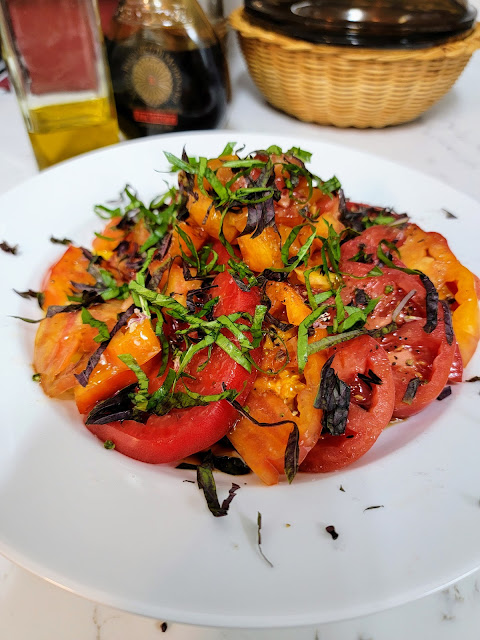PROBLEM SOLVED
Fruits and vegetables do not come in standard sizes. Neither do they ripen on your schedule. Often, for example, we miss the ideal time for using a tomato, and we need to do a little problem-solving. How to salvage a beautiful (and expensive) heirloom Mr. Stripey. when it has large soft spots and turn it into a salad? Well, read on to see how I solved that problem.
I sliced the rest of the beautiful heirloom tomatoes, cut off the soft spots and cut slices from the remainder. The odd-shaped pieces were diced and placed on top of the slices.
What turned a few tomato slices into a salad? I'm glad you asked.
- Season generously with Celtic Grey sea salt and freshly ground black pepper.
- Take the seed heads and flowers of fresh basil, pull them off and rub them between your hands and onto the sliced tomatoes. This is entirely optional, but if you're lucky enough to have this part of the basil plant, you'll taste a delicate spicy and peppery note. I even dry the seed heads and pop them into soups in the winter.
- Drizzle with a high-quality balsamic vinegar. Make sure it's not a glaze that's mostly added sugar. A good one doesn't have to cost a fortune, and it's a great investment because you don't need much to add lots and lots of flavor.
- Drizzle generously with a good olive oil.
- Top with a big bunch of fresh basil. Pull off the leaves, roll them together like a cigar, and slice thinly. This is a chiffonade cut. That's what you use.
- And now, just prior to serving, crown everything in an avalanche of shaved Italian cheeses (Asiago, Romano, Parmesan). Use one or all. Shave it yourself or use the pre-packaged mix if you're in a hurry.
When you ready to eat, toss it all into a big, glorious mess of over-the-top summer deliciousness. Serve with a simply prepared piece of pan-seared halibut, and let all of the salad flavors dress the fish. Don't complicate your plate. Keep it simple. Really!
Keep it simple with the fish. Dry the halibut with paper towels, season with salt and pepper. Heat a non-stick pan and add about two tablespoons of olive oil. Keep the heat on high. Place the fish in the pan skin side down and cook until the flesh has turned opaque. About five minutes depending on thickness. Flip it over and cook until lightly browned. Another 3 to 4 minutes. Warning: Better to undercook the fish than overcook it. Internal temperature in the thickest part of the fish should register 125 - 130 F. For another source on how to pan fry/sear halibut, this this step-by-step method from the Wild Alaskan Company. My method ensures crispy skin with a moist and flaky flesh side.
.jpg) |
| Toss everything into a glorious flavor-filled mess just prior to serving. |
 |
| Serve over pan-seared halibut. |
.jpg)








Comments
Post a Comment